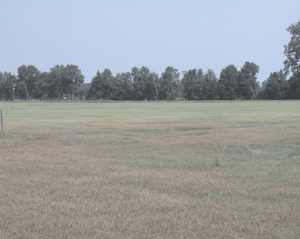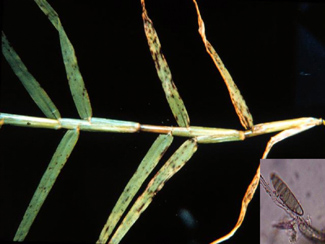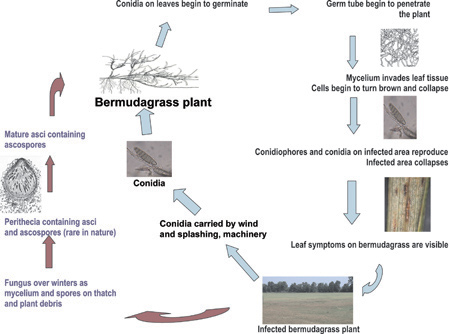- Overview
- Disease Symptoms and Identification
- Disease Management
- What if I Fail to Prevent the Disease?
- Summary
- Literature Review
Overview
Bermudagrass [Cynodon dactylon (L.) Pers.] is a warm-season perennial grass that is widely grown in the southern United States for pasture and hay. Like other warm-season plants, bermudagrass makes its best growth at 75-90 degrees F. Growth is slow when temperatures are below 60 degrees F and tends to decline above 95 degrees F. In Georgia, the season usage starts in March and finishes in October. Bermudagrass is by far the largest hay crop in Georgia, and it is estimated that more than 1.3 million acres of bermudagrass are currently used for this purpose. Some of the most common varieties grown in Georgia include Coastal, Tifton 44, Tifton 85, Alicia, and Russell. Bermudagrass is a high yielding, moderate quality, potentially high value hay crop.
 Figure 1. Alicia bermudagrass infected with Helminthsporium in Lowndes County, Georgia. Infected areas appear "bronzed" or red.
Figure 1. Alicia bermudagrass infected with Helminthsporium in Lowndes County, Georgia. Infected areas appear "bronzed" or red.Several environmental and biotic factors can reduce yield and quality of forage crops. Diseases are by far the most prevalent adverse factors affecting forages. Bermudagrass leaf spot is a disease that decreases yields, nutritive value and palatability. Bermudagrass leaf spot is caused by a fungus from the genus Helminthosporium and the disease has been informally called Helminthosporium leaf spot, Helminthosporium leaf blotch, or Leaf Blight. Recently, the genus Helminthosporium has been taxonomically reclassified into Cochliobolus (anamorph Bipolaris) and Pyrenophora (anamorph Dreschlera). Bipolaris cynodontis has been suggested as the probable causal agent of the disease. For identification and training purposes it continues to be known and informally named as Helminthosporium.
Leaf rust or Puccinia disease caused by Puccinia cynodontis has similar impacts as Helminthosporium in bermudagrass. Both diseases typically appear in late summer when weather is warm, usually between 75 degrees F and 90 degrees F, and with high relative humidity. Heavy infestations can decrease both hay yields and hay quality. Figure 1 shows an Alicia bermudagrass hayfield heavily infected with leaf spot.
Disease Symptoms and Identification
 Figure 2. Helminthosporium symptoms on bermudagrass. Inset shows close-up of conidiophores.
Figure 2. Helminthosporium symptoms on bermudagrass. Inset shows close-up of conidiophores.Helminthosporium or leaf blight can be identified from the characteristic circular lesions on the leaves (Figure 2). Leaf spots are more numerous near the collar of the leaf blade. Leaf lesions are irregularly shaped and brownish green to black in color. Infected plants may occur in irregular patches. Extensive damage occurs when the pathogen attacks crowns, stolons and rhizomes. Severely affected hayfields may become brown and thin. Under a microscope or hand lens the fruiting bodies (conidia or conidiophores) of B. cynodontis are cylindrical and multi-celled (inset of Figure 2). This clearly distinguishes Helminthosporium from rust urediniospores. The disease cycle of bermudagrass leaf spot/blotch is depicted in Figure 3.
 Figure 3. Bermudagrass leaf spot disease cycle.
Figure 3. Bermudagrass leaf spot disease cycle. Figure 4. Puccinia or leaf rust on bermudagrass. Inset shows magnified conidiophores of leaf rust.
Figure 4. Puccinia or leaf rust on bermudagrass. Inset shows magnified conidiophores of leaf rust.Leaf rust or Puccinia looks similar in nature to the naked eye as Helminthosporium (Figure 4), but can be identified microscopically by the more circular fruiting bodies in the inset. Numerous, small, red to orange lesions can be observed on leaf and stem tissue. Puccinia or rust lesions start as a small raised area or blister (pustule). The blister ruptures reveal a powdery mass of orange red urediniospores. Identification of the specific pathogen is interesting. For example, rubbing an infected leaf will leave rusty colored areas on your fingers or clothing. Disease management for leaf blight and leaf rust are similar, so both diseases will be broadly referred to as leaf spot in this bulletin.
Disease Management
The most effective way to treat bermudagrass leaf spot or blotch is avoidance. There are five management practices that are effective in decreasing risk of disease infection including: a) selecting a resistant bermudagrass variety, b) maintaining soil fertility, c) managing irrigation, d) removing thatch and e) harvesting forage in a timely manner.
Variety selection. Without a doubt the most effective practice to control leaf spot is to select a resistant variety. All selections that were released from Dr. Glenn Burton’s breeding program in Tifton, Georgia, were screened for leaf spot resistance. This means that Coastal, Tifton 44 and Tifton 85 all have some degree of disease resistance. While infected fields of Coastal or Tifton 85 are occasionally seen in Georgia, infections are not typically severe. Observations indicate that poor soil fertility or extremely damp weather has contributed to the problem.
Russell also appears to have good resistance to the leaf spot diseases. While there is no formal data on this resistance, few or no reports have surfaced regarding leaf spot diseases on this variety in Alabama or Georgia. On the other hand, some bermudagrass varieties are highly susceptible. While not a formal variety, common bermudagrass is often infected with leaf spot and is probably the most commonly reported susceptible “variety.” Most reported problems are in under-grazed pastures during late summer. Two improved varieties also appear to be extremely susceptible: Alicia and World Feeder. Note that both of these cultivars were introduced to Georgia from more arid areas of central Texas and Oklahoma. It is not uncommon to observe increased disease susceptibility when varieties originating from arid climates are introduced into more humid areas.
Soil fertility. Resistant varieties can still be infected with leaf diseases, particularly when soil fertility is low. The severity of leaf spot can be minimized using management practices once the stand is established. The most important practice is to sample soil and maintain adequate levels of fertility. Soil potassium is critical for leaf spot resistance. Most reported leaf spot cases are directly related to low soil potash. Nutrients are removed from bermudagrass hay fields in approximately a 4-1-3 ratio of N, P2O5, and K2O with hay harvest. That means that 75 percent as much potash as nitrogen should be applied each season. Potash can be applied in single applications in the heavy soils of north Georgia or in split applications in any portion of the state. Split applications are particularly helpful in sandy soils.
Please note that soil tests can be misleading. There have been cases where adequate soil levels were present, but plant tissue samples indicate a nutrient deficiency. If leaf spot has become a problem and soil tests do not recommend potassium, submit a clipped sample of hay for plant tissue analysis. If the sample analysis indicates a potassium level less than 1.8 percent on a dry matter basis, then apply additional potash.
Irrigation management. Fungal diseases thrive in warm and wet environments. While it is impossible to control moisture in dryland situations, with irrigated situations some control is possible. Leaf spot diseases need several hours of continual leaf wetness to thrive. Several producers have effectively decreased the prevalence of leaf spot infections on Alicia bermudagrass in southeast Georgia by turning off irrigation water from mid-afternoon until the following morning. This allows bermudagrass leaves to dry and prevents plants from staying wet through mid-morning the following day.
Minimize thatch. Some leaf spot infections appear to be associated with the amount of thatch present in hay fields, with heavy thatch loads producing higher incidences of leaf spot. Thatch ties up nutrients and contains abundant decaying material, which may serve as a “spore reservoir.” In addition, thatch retains water and reduces air circulation, creating humid conditions and promoting leaf spot incidence. The only practical way to reduce thatch is to burn in spring months just prior to bermudagrass green-up. Consult your local forestry group to make sure that all precautions are taken, as fires can easily escape.
Maintain a frequent cutting interval. Maintaining a proper cutting interval does more than keep nutrient quality of hay high. Timely cutting may improve leaf spot resistance, at least indirectly. The potassium necessary for leaf spot resistance is mobile in plants and typically moves from older to younger tissue when there is a nutrient deficiency. This predisposes older tissue to infection from leaf spot diseases. This topic has not been formally researched, but a wealth of information on other plant systems supports the logic behind this theory in bermudagrass species.
What if I Fail to Prevent the Disease?
There are no legal, effective or economical fungicides to control leaf spot in forage bermudagrass. This removes any possibility of chemical control. The only effective management practice in cases of severe infection is to remove the infected tissue and fertilize low fertility fields. Ideally, enough material is present to harvest as hay so that material can be removed from the field. Resulting hay quality will be decreased and palatability will be poor. Expect some refusal from animals. If there is too little forage present to bale, then grass can be mowed to encourage healthy regrowth. Unfortunately, mowing promotes additional thatch problems, so baling is preferable.
Summary
In summary, choosing a resistant variety is a crucial step in preventing bermudagrass leaf spot severity. Maintaining adequate levels of soil potash and decreasing the interval that leaf moisture is present are also helpful management tools. Removing thatch using dormant burns can release bound nutrients and may decrease disease incidence. Frequent harvests also minimize risk of infection and have the advantage of producing high quality hay.
When bermudagrass leaf spot infections occur, there are no fungicides that are legal, affordable or effective. Forage must be removed, and fertility should be checked and corrected to prevent future outbreaks.
Literature Review
- Farr, D.F., G.F. Bills, G.P. Chamuris, and A.Y. Rossman. 1995. Fungi on plants and plant products in the United States. St. Paul, Minn: APS Press.
- Kreitlow, K.W., J.H. Graham, and R. J. Garber. 1953. Diseases of forage grasses and legumes in the northeastern states. Penn State University. Bulletin 573.
- Smiley, R.W., P. H. Dernoeden, and B. B. Clarke. 2000. Compendium of Turfgrass diseases. St. Paul, Minn: APS Press.
- www.plantbiology.msu.edu
- www.georgiaforages.com
- coris.noaa.gov/glossary
- ipm.illinois.edu/diseases/series300/rpd313/ [formerly: www.ipm.uiuc.edu/diseases/series300/rpd313/]
Status and Revision History
Published on Sep 15, 2005
Published on Mar 25, 2009
Published with Full Review on Mar 29, 2012
Published with Full Review on Oct 21, 2022


























































